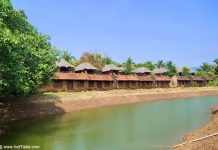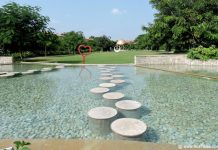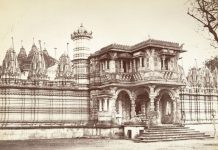Rani Ki Vav is an ornate stepwell, a UNESCO World Heritage site, located in the ancient Patan city of Gujarat. There are many step wells in this area, Sahastralinga Talav is right behind this one. However, all of them put together cannot match the grandeur of Rani Ki Vav.

Rani Ki Vav is not only magnificent in terms of size but its intricate sculptures make it a work of art while being a place of utility. The whole structure is below the ground level. So when we walked towards it after buying the tickets, all we could see was green manicured lawns with pathways leading to a kind of hole in the ground.
It is a wonder both in size and well the sheer number of sculptures it contains even after you discount all that is lost to time.
Today it proudly finds a place on the Rs 100 currency note, printed by RBI.
Visiting Rani Ki Vav – Most Ornate Stepwell

Stepwell Rani Ki Vav
As you reach the hole, you realize it is the top end of the stepwell. From here, you see giant steps, structures built on some steps, and lovely carvings on the sidewalls. As you keep going down on the triangular steps joining the big steps, the beauty of step well starts revealing itself step by step.
The further you go, the more ornate and enchanting it becomes. It was probably as ornate at all levels but the lower levels have survived well. Also, at the lower levels, you are kind of encompassed in the step well – cut off from the rest of the world. That is when you best admire the stories written in stone.

As you walk up and down, think of people sitting around – socializing, praying, meditating, and just relaxing. Imagine travelers sitting and sharing stories of far-off places.

Four Pavillions
The four pavilions that demarcate the stages during the descent from the eastern side had two, four, six, and seven stories respectively. The roof of the uppermost story of each pavilion reached the ground level.
After digging the place builders might have taken a bottom-up approach to construction by building the walls of the lowest floor first. Then, they would have added pillars of pavilions strengthening the foundation first before constructing the higher storeys.
You can also from the west side to reach the tank and the draw-well directly. You would miss most of the ornate part then.
Grandeur from Third Story and Below
The higher two level’s stepped-corridor sculptures are damaged. Third level onwards the grandeur reveals itself. Though many sculptures are missing, you can see beautiful Patola-style geometric decorative patterns carved on the walls. Popular and famous traditional Patola textile weaves from Patan were inspired by the monument or vice versa.
Reservoir
The water tank or reservoir to collect surplus water from the well is rectangular in shape and about 7 meters square in size. This too is elaborately treated. The bed of the tank has a bracing structure consisting of pillars and beams to buttress the walls on the north and south. Walls around the reservoir have many stone sculptures of Sri Vishnu avatars.
Deep Well
The deep well at the end of the structure can be viewed from the top by going around the structure. The pavilion facing the well has the sculptures of the Hindu trinity of Brahma-Vishnu-Shiva with Saraswati, Lakshmi, and Parvati respectively along with Ganesh and Kubera sculptures. Well too has sculptures carved on all its walls. It apparently had a direct staircase to go down.
All that you can see from above now are some brackets that would have jetted out or held a superstructure over them. At the edge of the water Vasu’s, stand with folded hands representing Ganga. An image of lying Vishnu on Shesh Shaiyya or snake bed can be seen at the base of the well from the lowermost part of the step well. It symbolizes the water of the well as Ksheersagar – where the Vishnu resides in this form. A similar figure is also seen at Abhaneri Stepwell in Rajasthan.
Reportedly, the well had water till 1988, but now it is dry.
Stepwells Evolution
Technically speaking, this region of Gujarat gets scanty rainfall and has sandy soil. Groundwater levels go down significantly, so, deeper wells were required to source water during the dry seasons. These stepwells were built near the drying rivers as there is a better probability of finding water.
Over a period of time, the architecture around subterranean, multi-storied, adorned, pillared, pavilion step-wells evolved to provide life-giving drinking water to citizens. The engineering, perfected over centuries, was ingenious. Water enters through an opening in the well cylinder, the levels go up and down depending on the season. In dry months, people descended many steps to reach water, but during the monsoons, when the water table was high, levels could reach the uppermost step.
Our scriptures mention building stepwells or waterbodies in general as something that earns you Punya or merits. No wonder we see many commemorating the rich and famous of their times.
In Rajasthan stepwells are called Baolis or Bawadis, in South India, they are called Pushkarnis and in Gujarat, they are called Vav.
How big is Rani Ki Vav?
Built in the Maru-Gurjara architecture style, Rani ki Vav is enormous – 210 feet long, and 65 feet wide as per ASI Plaque. You see a similar style at Modhera Sun Temple close by.
It is a seven-story structure underneath from the ground level.
The roof of the monument is about 100 ft deep underground. 88 feet deep cylindrical well with a shaft 10 meters in diameter, stands at the western end of the monument. Its top is open to the sky and its interior is also exquisitely carved with figures of deities or geometrical designs.
292 stone pillars support the pavillions, of which 226 remain intact, some in fragments.
It has been built along the east-west axis with a grand Torana at the entrance.
Geotectonic changes in the 13th CE changed the course of the Saraswati River bed. The well no longer functioned as a water source. However, the silting of the flood caused during this geological event, allowed for the exceptional preservation of Rani-ki-Vav for over seven centuries. Recently, ASI has silted up and restored this amazing archeological marvel.
Is it an Inverted Temple?
Some scholars believe that Rani Ki Vav is an inverted temple with its shikhara located at the lowest 7th level. I do not agree with this view. I think the water is the most important Tirtha and water itself is the deity.
Having deities surrounding the life-giving water adds sanctity to the whole place.
History
Patan was the ancient capital of the Solanki dynasty who ruled from here around the turn of the first millennium. Queen Udayamati – consort of Solanki King Bhimadeva I, built this step well in late 11th CE. She was the daughter of Khengara of Saurashtra. It was commissioned in 1063 CE and took 20 years to complete.
The primary purpose of the building step well was, of course, water management as this region gets scanty rainfall. Other purposes would be to earn ‘Punya’ or merit that you get by giving water to people who need it. As I stood there, I also felt that all the religious icons carved all over the step well may have been to keep it clean and pure.
It is one of the many such monuments built by women in India.
The restoration of this monument by ASI started in 1981 and was completed in 1987.
It was the 2014 UNESCO World Heritage Site entry from India.
Sculptures at Rani Ki Vav
The walls of the step well are full of ornate stone carved sculptures. These are placed in well-arranged panels divided into niches. You can study them like you read a comic strip. The walls, pillars, columns, brackets, and beams, are all ornamented with carvings. The niches on the side walls contain the most beautiful and delicate sculptures.
The platforms linking the two walls at each level are pillared corridors that allow you to stand in the middle and admire the step well symmetrically. The pillars have the typical formation with a Kalash or pot encased in stone that we saw at many places across Gujarat. A lot of geometric patterns are carved on some panels between the sculpted ones.
As per ASI, there were about 800 large stone sculptures. These were primarily of the Hindu deities like Brahma-Vishnu-Mahesh, Sarawawati, Lakshmi and Paravati, Vasus, Buddha, Hari Hara, Hanuman, and Kubera.
Some important sculptures at the stepwell include:
Dashavatar
The most prominent sculptures primarily on the side walls are those of large Dashavataras or the ten incarnations of Lord Vishnu. You can see from Matsya Avatar to Kalki Avatar complete with their attributes. All are in standing position and look identical till you pay attention. It is like walking through the Vishnu Puran.
Varaha’s avatar with a wild boar’s head and the human body is lifting Mother Earth from the ocean.
Vamana’s avatar is seen as a student with minimal clothing, holding a mala in his right hand. Do note the shrivatsa mark on his chest indicating him as one of the Vishnu avatars.
Kalki, the future avatar to destroy the evil forces, is seen as a warrior wielding a sword and riding horseback.
Madanikas or Apsaras
The main sculptures are punctuated with the auspicious figures of women who are adorned with 16 Shringar or adornments. They represent all that is auspicious like prosperity and growth, and hence attract more of it.
They are depicted in poses of worship like holding garlands, conch shells, and lamps. Then they are seen dancing, gazing into a mirror, taking baths, wearing earrings or anklets, etc.
Apsaras showcase the Solah-Shringar, a term used to describe the 16 different styles of make-up used to make a woman look more attractive.
There are some sculptures of Nagakanyas or serpent maidens.
Mahishasuramardini
The sculpture of Mahishasuramardini in her violent and aggressive form seen killing the buffalo demon is worth noticing. She holds a trident, thunderbolt, arrow, mace, spear, discus, sword, shield, bell, cobra, war horn, bow, noose, and a lotus in her hands. In the scene depicted, her lion attacks the buffalo from the rear. It buckles with its tongue hanging out and Mahishasur emerges in the human form.
Another interesting sculpture is that of twenty armed, angry pose dancing Bhairava.
A rare sculpture of sage Agastya was reportedly recovered during the de-silting & clearance of the monument done during the period around 1987.
The sculpture of Queen Udayamati, the patroness of the step-well, was also there. I could not find it either at the stepwell or at the museum nearby.


Patan, Gujarat

After visiting this heritage monument at Patan, you would come back admiring the two-fold approach to life that our ancestors had more than 1000 years ago. They could not only rein in all the water that little rainfall offered in the region. But also make it a place that people would enjoy visiting. A primer on the beliefs and culture of the times for future generations.
Travel Tips
Rani Ki Vav is about 140 km from Ahmedabad. You can easily visit it as a day trip from Ahmedabad.
Monuments are open from Sunrise to Sunset. Ticket is nominal.
You need some endurance to go down and come up the stepwell. An ASI guide would help you identify the sculptures on the walls of Stepwell.
Do not miss the Sahastralinga Talav located right behind Rani Ki Vav.
Sun Temple Modhera is also close by and can be seen together.













Unbelievable but I have to believe.
Thanks for writing.
Such wonderful architecture. Nice one, Anuradha.
Amazing site. Not sure which we like the most: that this is yet another site in India inspired by love or that it’s an ingeniously decorative way to capture and store rainwater. Nice post. Looks like something kids would enjoy visiting as well.
Thanks Tushar & Niranjan.
BWLE Travel – I think it is a heritage that kids ought to be aware of…
nice to read this post…
happy blogging!!!
Damn ! I have missed seeing this in while. Should go back. Gujarat has such variety culture that even being a Gujarati ,I have missed quite a lot.
I really had fun really you articles! It was so amazing, and I can’t it to stop reading your blog. Just keep it up!
Nice that you highlighted the open cave just at the right time when a hundred rupee note tosses up in its grave.
Isn’t it sad that such marvels have stayed hidden due to callous governments. Many of us have missed the chance of seeing these and aspire to go to see pyramids
Mike, at IndiTales we try to show India to Indians and hope that they would travel to these hidden destinations that are not just beautiful but our very own heritage.
Amazing Article, You can explore Rani ki Vav in 3D.
Can you give me some more pictures of the sculptures of rani ki vav??
Excellent piece of architecture. Must visit place.
Can I contribute the first image in this article in my office blog?
You can do so with due credits to IndiTales and preferably a link back to original article.